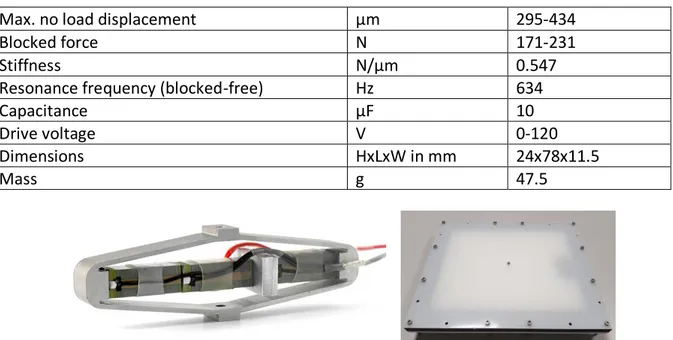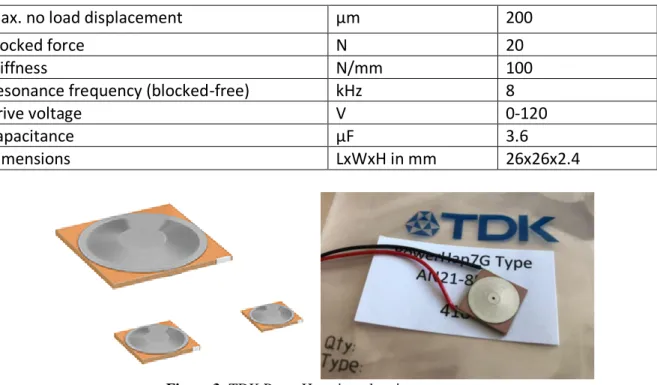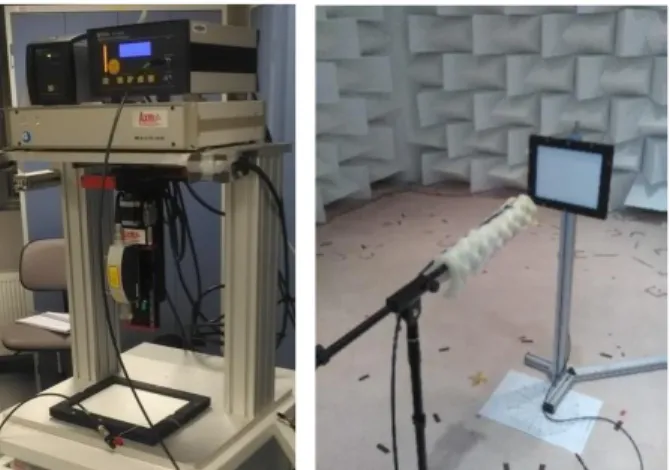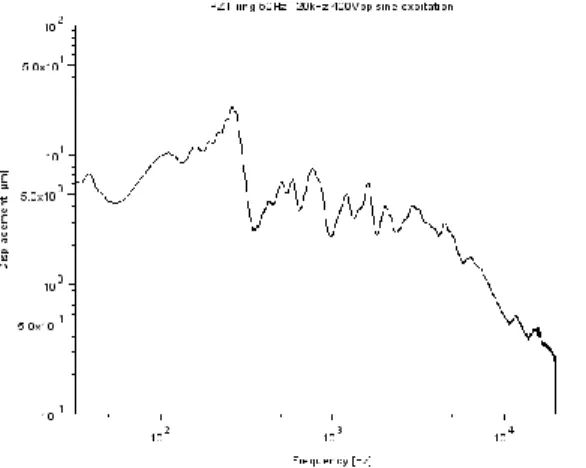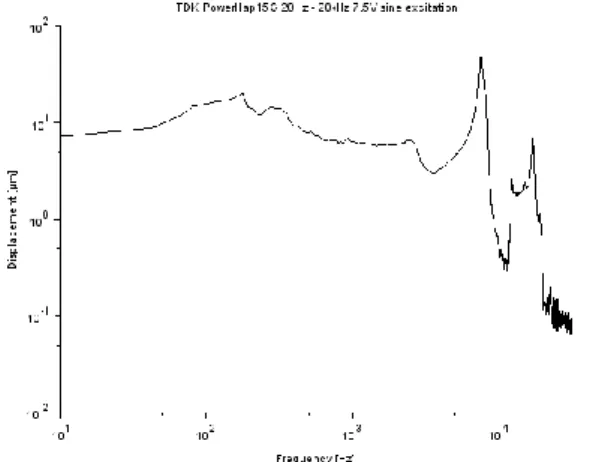HAL Id: hal-03013697
https://hal.archives-ouvertes.fr/hal-03013697
Submitted on 2 Dec 2020HAL is a multi-disciplinary open access archive for the deposit and dissemination of sci-entific research documents, whether they are pub-lished or not. The documents may come from teaching and research institutions in France or abroad, or from public or private research centers.
L’archive ouverte pluridisciplinaire HAL, est destinée au dépôt et à la diffusion de documents scientifiques de niveau recherche, publiés ou non, émanant des établissements d’enseignement et de recherche français ou étrangers, des laboratoires publics ou privés.
Distributed under a Creative Commons Attribution| 4.0 International License
Piezoelectric transducer for low frequency sound
generation on surface loudspeakers
Christian Bolzmacher, Nassim Benbara, Marc Rebillat, Nazih Mechbal
To cite this version:
Christian Bolzmacher, Nassim Benbara, Marc Rebillat, Nazih Mechbal. Piezoelectric transducer for low frequency sound generation on surface loudspeakers. IX ECCOMAS Thematic Conference on Smart Structures and Materials, Jul 2019, Paris, France. pp.1-10. �hal-03013697�
PIEZOELECTRIC TRANSDUCER FOR LOW FREQUENCY SOUND
GENERATION ON SURFACE LOUDSPEAKERS
CHRISTIAN BOLZMACHER*, NASSIM BENBARA†, MARC REBILLAT† AND NAZIH MECHBAL†
*
CEA, LIST, Sensorial and Ambient Interfaces Laboratory, 91191 - Gif-sur-Yvette CEDEX, France. e-mail: christian.bolzmacher@cea.fr, www-list.cea.fr
† Processes and Engineering in Mechanics and Materials Laboratory (CNRS, CNAM, ENSAM), 151,
Boulevard de l'Hôpital, Paris, F-75013, France.
Key words:Piezoelectric actuators, Surface loudspeaker, Bending wave loudspeaker.
Abstract. This paper describes the comparison of three different types of piezoelectric actuators
for application in sound emitting panels so-called load-bearing surface loudspeaker. The first actuator is a piezoelectric ring glued directly to a polypropylene surface of dimension 300 x 200 x 3 mm3. The other two are mechanically amplified piezoelectric actuators of the flat and the cymbal flextensional-type tested in a reactive configuration on the same sized polypropylene panel. Those actuators are compared in terms of vibration response measured with a laser vibrometer and audio response measured with a microphone.
1 INTRODUCTION
In the foreseeable future, the adoption of multifunctional car structure (MCS) will offer the potential to radically upgrade the abilities of vehicles in terms of ecological requirements emerging from the social and legal environment. Integrating car structures with functional systems that monitor structural integrity and aging, change shape at local level, act as sound sources and tackle noise vibration harshness issues will eliminate many of the weight, volume, and signature penalties associated with the current approach of designing, manufacturing and maintaining vehicles and functional systems separately. One type of MCS that appears as very promising and which we propose to investigate in this paper is a Load-bearing Loudspeaker Structure (LLS). A LLS refers to structures that are equipped with active elements such as piezoelectric elements that allow for music reproduction and 3D sound spatialization. We consider the fact that the passenger cabin of cars consists of many large surrounding surfaces such as door panels, roof trim panel, trims and dashboards, which can act as membranes. The objective is thus to design surface loudspeaker able to efficiently reproduce sound in the low, medium and high frequency range depending on the sound panel size. Piezoelectric transducers chosen because of their small size, low weight and high force output are investigated in this paper. They are coupled to mechanical amplification units to increase displacement amplitudes to overcome the lack of low frequency sound production [1,2] and are compared to a piezoceramic ring. The goal is to efficiently excite the full audio spectrum.
2 PIEZOELECTRIC ACTUATORS
Piezoelectric materials used in this work are ceramic perovskite materials made from lead zirconate titanate (PZT) that expands or contracts when an electrical charge is applied, generating motion and force called the inverse piezoelectric effect. Piezoelectric actuators use this motion to provide very short high force strokes with high frequency and fast response times at small size giving them a significant power-to-size ratio. Bulk piezo ceramics with external electrodes provide deformations in the range of 300 ppm with fields of 600 kV/m requiring high driving voltages. Multi-layer piezoelectric ceramics have been developed with the aim to reduce the required voltage by reducing the PZT layers to 50 to 100 µm thickness placed between internal electrodes. Those materials can be driven with a maximum electric field up to 2 MV/m with a voltage of less than 200 V achieving a deformation of about 1000 ppm.
Depending on the application, piezoelectric ceramics can be glued directly to a surface or a structure introducing a bending-type deformation. Alternatively, the high output force can be transformed into an amplified deformation at the expense of the size of the actuator due to the required amplification unit. If the amplification unit is rigidly coupled to the piezoceramic, these actuators are called flextensional actuators. Three different actuator types are described in the next sections:
• Piezoelectric rings
• Flat flextensional piezoelectric actuators
• Cymbal-type flextensional piezoelectric actuators
3.1 Piezoelectric ring
The first prototype of a sound-emitting panel uses a piezoceramic ring of dimension OD50 mm, ID20 mm, and TH 0.5 mm. It is made of a hard Navy I-type material called Pz26 from Meggitt Ferroperm with good coupling factors, high Curie temperature, high mechanical quality factor, low dielectric loss and very good stability over time. Table 1 shows the material characteristics. This piezoceramic ring is glued centered to a 300 x 200 x 3 mm3 plate made of polypropylene, a material often used for car passenger garnishments. The plate is screwed via a spacer (thickness 6.7 mm) to another stiffer plate made of Delrin creating a closed housing. The final assembly is shown in Figure 1.
Table 1: Material parameters Meggitt Pz26.
Relative dielectric permittivity k33 - 1300
Curie temperature °C 230
Piezoelectric charge coefficient d33 pC/N 300
Figure 1: Polypropylene plate with centered piezoelectric ring (left) and prototype speaker with housing (right).
3.2 Flat flextensional piezoelectric actuator
Flat flextensional piezoelectric actuators transform the high output force of piezoelectric ceramics into an amplified displacement. The actuator used in this work is called “Amplified Piezoelectric Actuator” (APA) developed by Cedrat Technologies based on a low voltage piezoelectric ceramics stack. The mechanical amplification is obtained due to an external monolithic shell of elliptic shape made of stainless steel, which magnifies the stack deformation in normal direction. This elliptical frame preloads the piezoelectric ceramic stack and protects it from tensile force. This kind of mechanical amplifiers is especially well-suited for dynamic drive conditions and provide relatively high force and large displacement while being compact in size. The APA400MML model has been chosen because of its good compromise between force and displacement output. Characteristics are given in Table 2. For the experimental tests, the actuator has been screwed in a reactive configuration centered between two plates. The sound emitting membrane of size 300 x 200 x 3 mm3 is made of polypropylene and the back plate is made of Delrin (thickness 6.7 mm) as shown in Figure 2.
Table 2: Characteristics of an APA400MML from Cedrat Technologies.
Max. no load displacement µm 295-434
Blocked force N 171-231
Stiffness N/µm 0.547
Resonance frequency (blocked-free) Hz 634
Capacitance µF 10
Drive voltage V 0-120
Dimensions HxLxW in mm 24x78x11.5
Mass g 47.5
Figure 2: APA400MML from Cedrat Technologies (left) and surface speaker prototype with centered actuator
3.3 Cymbal-type flextensional piezoelectric actuator
The cymbal transducer consists of a piezoelectric or ceramic disc (either in single layer or multilayer form) sandwiched between two metal endcaps, each having a truncated conical shape. These metal endcaps serve as a mechanical transformer for converting and amplifying the lateral displacement of the ceramic into an axial motion of the endcaps. Both the d33 and d31 piezoelectric coefficients contribute to the axial displacement of the composite. Displacement increases exponentially with increasing cavity diameter and increases linearly with increasing cavity depth. Displacement is inversely proportional to the endcap thickness. Displacement and generative force show a position dependent behavior.
TDK PowerHap™ piezoelectric actuators provide high performance in terms of acceleration, force, and response time. They are made of multilayer piezo plates with copper inner electrodes. This allows the actuators to be driven with relatively low operating voltages up to 120V. Once activated, the piezo plates only expand minimally in the z axis, but due to the constant volume of the piezo effect contract simultaneously in both the x and y axes. The actuators employ cymbals on both sides of the plate as levers to amplify the contraction by a factor of 15 in the z axis. The biggest actuator of the PowerHap™ series, the PowerHap™ 15G, is used in this paper with its characteristics given in Table 3. The actuator is also fixed in a reactive configuration between two plates of dimensions 300 x 200 mm3.
Table 3: Characteristics of the TDK PowerHap 15G actuator.
Max. no load displacement µm 200
Blocked force N 20
Stiffness N/mm 100
Resonance frequency (blocked-free) kHz 8
Drive voltage V 0-120
Capacitance µF 3.6
Dimensions LxWxH in mm 26x26x2.4
Figure 3: TDK PowerHap piezoelectric actuators.
4 EXPERIMENTAL TEST SET-UPS
investigate the dynamic behavior of the actuators. Erreur ! Source du renvoi introuvable. shows the experimental test set-up using a Polytec 5000 laser vibrometer with an OFV-534 laser head mounted on a 3-axes cartesian robot. This experimental set-up allows to measure the dynamic displacement response of a single point on an actuator or a surface as well as the scanning of a complete surface to determine the mode shapes of the vibrating plate.
Acoustic characterizations are carried out in a semi-anechoic chamber (i.e. whose floor is not covered with foam) in order to not alter the acoustic signal recorded by the microphone (Figure 4). The prototype plate is on a stand, at the same height and a distance of 1 m from the microphone, itself on a tripod (1 m from the ground). An APEX220 microphone from Apex Electronics is used for the measurements connected via an XLR cable to a Focusrite Scarlet2 6i6 soundcard connected via USB to the computer. Each set of measurements begins with a "blank" measurement of the room, with a sound level meter, to determine the sound level (about 29 dB within the room in general). The amplified piezoelectric actuators in this paper are driven with a Piezomechanik LE 150/100 EBW amplifier. It generates voltages between 0 V and 150 V to be obtained with a preset offset voltage from a 0 V to 5 V input. The gain is x30 and its no load bandwidth extends up to 70 kHz. The amplifier can supply up to 350 mA continuously and 1200 mA peak. This leads to a rapid decrease in its bandwidth with increasing load. The piezoceramic ring is driven with an ELBATEC T-500 symmetrical high-voltage amplifier. It generates voltages of ±200 V from a ±10 V input. The maximum current is 400 mA and the no-load bandwidth extends up to 100 kHz.
Figure 4: Set-up for displacement measurements with a laser vibrometer (left) and acoustic measurements in a
semi-anechoic chamber (right).
5 MEASUREMENT RESULTS 5.1 Piezoelectric ring
First, the displacement behavior at the center of the plate is measured with the laser vibrometer. Therefore, a 400 Vpp sine sweep is applied to the piezoelectric ring element. The loudspeaker is screwed to the base of the scanning table as shown in Figure 4 to prevent any unintended movement. Figure 5 shows the result for an excitation frequency from 50 Hz to 20 kHz. It can be seen that the absolute displacements are in the low micrometer range from 0.3 µm to 25 µm decreasing towards higher frequencies.
Next, the sound pressure level of the piezoelectric ring speaker has been characterized from 100 Hz to 20 kHz for a driving voltage of 400 Vpp. The sound pressure level (SPL, the reference level corresponds to the threshold of hearing, 20 μPa) is shown in Figure 6 measured in the semi-anechoic chamber. A 1/12 octave filter has been applied to the SPL curve. Due to the low capacitance of the ring actuator, high frequencies with relatively low power consumption can be attained. However, the low frequency range is quite limited. Despite of a few acoustic holes an average SPL of 80 dB is emitted up to 20 kHz. The lower cut-off frequency with this polypropylene plate is around 400 Hz reaching a SPL of 75 dB.
Figure 5: Displacement response of the PZT ring
speaker measured at the center of the plate.
Figure 6: SPL of the PZT ring speaker measured at
1 m at 400 Vpp.
5.2 Flat flextensional piezoelectric actuator
As for the piezoelectric ring, laser vibrometer displacement measurements have been carried out for the APA400MML actuator. First, the frequency response has been measured for frequencies from 20 Hz to 20 kHz for the actuator only. A 7.5 Vpp sine sweep (offset 3.75 V) was applied to the piezoelectric actuator with a duration of 2 s. The result is shown in Figure 7. It can be seen that the APA400MML actuator has linear displacement behavior up to its first resonance frequency indicated at 634 Hz by the supplier. Figure 8 shows the displacement frequency response for a 150 Vpp (offset 75 V) sine sweep from 100 Hz to 500 Hz. This is the maximum driving voltage that can be applied to the actuator. At those driving voltages, the actuator cannot be actuated on its first resonance, which would cause failure to the ceramic due to excessive tensile stress. The supplier indicated a mean maximum peak to peak displacement amplitude of 368 µm up to the first resonance frequency. It has to be noted that one of the three piezoelectric ceramics composing the APA400MML actuator was electrically damaged and has been electrically removed from the actuator. Driven with only two ceramics the measured peak displacement amplitude is around 150 µm before the first resonance frequency but the voltage amplifier can now fully charge the actuator up to 500 Hz.
Next, the Cedrat Technologies APA400MML speaker has been characterized in the semi-anechoic chamber. A 7.5 Vpp sine sweep of 5 s has been applied to the actuator and measured with the microphone. In Figure 9, the 1/12 octave filtered sound pressure level from 100 Hz to 20 kHz is shown. It can be seen that even at very low driving voltages relatively high levels can
be attained in the range from 400 Hz to 2 kHz. For higher frequencies, the membrane material as well as the characteristics of the actuator induce damping lowering the maximum sound pressure level. Figure 10 shows the transfer function for a 150 Vpp (75 V offset) sine sweep excitation from 100 Hz to 500 Hz. As described earlier, this kind of actuator cannot be driven in resonance, which would lead to breakdown of the ceramics. It can be seen that SPLs exceeding 75 dB can be achieved from 1500 Hz to 600 Hz using this kind of actuators and the current surface size. It may be convenient to increase the size of the membrane to achieve higher levels at lower frequencies.
Figure 7: Displacement amplitude frequency
response of the APA400MML actuator for a 7.5 Vpp driving voltage (2 s sine sweep) from 10 Hz to
20 kHz.
Figure 8: Displacement amplitude frequency
response of the APA400MML actuator for a 150 Vpp driving voltage (2 s sine sweep) from 100 Hz
to 500 Hz.
Figure 9: SPL from 100 Hz to 20 kHz of the
APA400MML speaker at 7.5 Vpp.
Figure 10: SPL from 100 Hz to 500 Hz of the
APA400MML speaker at 150 Vpp.
4.3 Cymbal-type flextensional piezoelectric actuator
Finally, the displacement amplitude of the TDK PowerHap 15G actuator has been measured. Figure 11 shows the peak displacement amplitude from 100 Hz to 20 kHz with an almost linear
zone below the first resonance frequency around 8 kHz. The mean peak amplitude at 7.5 V is around 10 µm. Figure 12 shows the frequency response for a 2 s sine sweep from 100 Hz to 1 kHz at 120 Vpp with an offset of 60 V (maximum driving voltage). The almost horizontal plateau has a peak displacement amplitude of 80 µm. This actuator can be fully charged up to 1 kHz by the amplifier used in this paper.
The sound pressure level of the TDK PowerHap 15G speaker has been characterized in the semi-anechoic chamber. A 120 Vpp (offset 60 V) sine sweep of 5 s has been applied to the actuator and measured with the microphone. Figure 13 shows the sound pressure level from 100 Hz to 20 kHz. Relatively high SPLs are achieved between 500 Hz and 2.5 Hz. There is a small hole present in the transfer function from 1.2 kHz to 1.6 kHz due to the insufficient charging of the actuator by the amplifier (limited to 1 kHz for this actuator). Next to the APA actuators, this actuator is an interesting candidate to excite the car structures because of its compact geometry, relatively low power consumption and high displacement amplitude.
Figure 11: Displacement amplitude frequency
response of the TDK PowerHap 15G actuator for a 7.5 Vpp driving voltage (2 s sine sweep) from
100 Hz to 20 kHz.
Figure 12: Displacement amplitude frequency
response of the TDK PowerHap 15G actuator for a 120 Vpp driving voltage (2 s sine sweep) from
100 Hz to 1 kHz.
6 DISCUSSION
The study revealed that the piezoceramic ring can be used for exciting the medium to high frequency audio range. In practice, lower maximum voltages will be applied reducing the sound pressure level and thus affecting primarily the lower end of the excited frequencies. This will shift the addressable audio range to higher frequencies. This can be partially compensated by using multiple piezoceramic actuators. The advantage if these actuators is their minimal size requirement and surface conform integration.
The amplified piezoelectric actuators can address the medium low frequencies from 150 Hz to 2.5 kHz. The APA series can easily be adapted to a targeted audio range but may introduce actuators of bigger size. The PowerHap actuators stand out by their small size and relatively high output displacement. Output force may be an issue depending on the LLS stiffness. In both cases, the voltage amplifiers are the main limitation factor for speaker applications. Using different membrane materials with higher Young’s modulus and lower damping than the polypropylene material used in this paper can increase the sound pressure level but may introduce coloration to the created sound. In general, to achieve a proper radiation efficiency and radiated sound power, the Young’s modulus cannot be too low. A tradeoff between Young’s modulus and the density needs to be found to design efficient LLS.
Compared to classical electrodynamic speaker, the piezoelectric actuators are not visible and can be applied to structures that have initially other functions than creating sound. After equalization, LLS performance could be similar to electrodynamic speaker, at least subjectively. The process of equalization basically cancels out the lack of certain frequency band, and thus, is no longer affecting the performance. The use of sophisticated control schemes applied by a digital signal processor when using multiple actuators could significantly improve sound quality even on complex structures. The implementation of piezoelectric actuators is then a good choice because they can be more easily controlled then electrodynamic exciter technology.
7 CONCLUSIONS
Three different actuators have been compared in this paper in terms of maximum displacement amplitude and maximum sound pressure level on 300 x 200 x 3 mm3 speaker surfaces. A flat piezoelectric ring glued to a surface is compared to amplified piezoelectric actuators. The ring actuator produces good sound pressure levels at frequencies higher than 400 Hz but excites confuse mode patterns due to the stiff ceramic glued to the surface making control schemes more challenging. The other two actuators have been tested in a reactive configuration (fixed between two plates) to overcome the diffuse mode patterns created by a piezoceramic disc or ring glued to a surface. Highest output displacements can be obtained with the APA400MML flextensional actuator from Cedrat Technologies, which is limited to a maximum frequency of around 500 Hz due to its first mechanical resonance. Due to the high capacitance, this actuator is relatively power consuming. It’s maximum output force of 200 N is not necessary for the speaker surface used in this paper but gives much design space for applications with complex and stiff structures. A smaller piezoceramic stack could be used to reduce power consumption. The flat cymbal actuator from TDK named PowerHap 15G produces a force of 20 N, which is enough to displace the membrane. Good acoustic power is
produced between 500 Hz and 2.5 kHz. Power consumption is reduced by a factor of three compared to the APA400MML actuator because of the lower capacitance (3.6µF compared to 10µF). The very compact design (26 x 26 x 2.4 mm3) could make this actuator a good choice for medium frequencies in car applications. The limiting factor for high frequency sound generation using those amplified piezoelectric actuators is the availability of high-power electric amplifiers. In order to cover a large audio spectrum, the combination of simple piezoelectric ceramics with amplified piezoelectric actuators on the same loudspeaker panel can be advantageous to maintain low power consumption.
ACKNOWLEDGEMENTS
This work was financially supported by the French National Research Agency (ANR, contract ANR-17-CE33-0004).
REFERENCES
[1] Bai, M.R. and Lu, Y. Optimal Implementation of Miniature Piezoelectric Panel Speakers Using the Taguchi Method and Genetic Algorithm. J. Vib. Acoust (2004) 126(3):359-369.
[2] Sugimoto, T., Ono, K., Ando, A., Kurozumi, K., Hara, A., Morita, Y. and Miura, A. PVDF-driven flexible and transparent loudspeaker. Applied Acoustics (2009) 70(8):1021-1028.
[3] APA400MML from Cedrat Technologies,
https://www.cedrat-technologies.com/en/products/actuators/amplified-piezo-actuators.html.
[4] PowerHap 15G from TDK Corporation,

